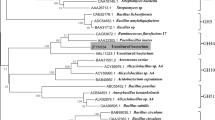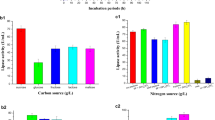Abstract
A fungus strain ECU2002, capable of enantioselectively hydrolyzing chiral lactones to optically pure hydroxy acids, was newly isolated from soil samples through two steps of screening and identified as Fusarium proliferatum (Matsushima) Nirenberg. From the crude extract of F. proliferatum ECU2002, a novel levo-lactonase was purified to homogeneity, with a purification factor of 460-folds and an overall yield of 9.7%, by ultrafiltration, acetone precipitation, and chromatographic separation through DEAE-Toyopearl, Butyl-Toyopearl, Hydroxyapatite, Toyoscreen-Super Q, and TSK-gel columns. The purified enzyme is a monomer; with a molecular mass of ca 68 kDa and a pI of 5.7 as determined by two-dimensional electrophoresis. The catalytic performance of the partially purified levo-lactonase was investigated, giving temperature and pH optima at 50°C and 7.5, respectively, for γ-butyrolactone hydrolysis. The substrate specificity of the partially purified lactonase was also examined using several useful lactones, among which α-hydroxy-γ-butyrolactone was the best substrate, with 448-fold higher lactonase activity as compared to γ-butyrolactone. The F. proliferatum lactonase preferentially hydrolyzed the levo enantiomer of butyrolactones, including β-butyrolactone, α-hydroxy-γ-butyrolactone, α-hydroxy-β,β-dimethyl-γ-butyrolactone (pantolactone), and β-hydroxy-γ-butyrolactone, affording (+)-hydroxy acids in high (94.8∼98.2%) enantiomeric excesses (ee) and good conversions (38.2∼44.2%). A simple immobilization of the crude lactonase with glutaraldehyde cross-linking led to a stable and easy-to-handle biocatalyst for catalytic resolution of chiral lactones. The immobilized lactonase also performed quite well in repeated batch resolution of dl-pantolactone at a concentration of 35% (w/v), retaining 67% of initial activity after ten cycles of reaction (corresponding to a half life of 20 cycles) and affording the product in 94∼97% ee, which can be easily enhanced to >99% ee after the d-hydroxy acid was chemically converted into l-lactone and crystallized.





Similar content being viewed by others
References
Adam G, Seebach D (1988) (2S, 3R)-2-Benzyloxy-3, 4-epoxybutan-1-ol: a versatile synthetic building block formally derived from tartaric acid. Synthesis 5:373–375
Akbutina FA, Sadretdnov IF, Selezneva NK, Miftakhov MS (2003) Chiral synthetic block based on (R)-pantolactone. Mendeleev Commun 3:151–152
Angelis FD, Fusco ED, Desiderio P, Giannessi F, Piccirilli F, Tinti MO (1999) Inversion of configuration of (S)-α-hydroxy-γ-butyrolactone with total retention of the enantiomeric purity. Eur J Org Chem 11:2705–2707
Blandin V, Carpentier JF, Mortreux A (1998) New one pot synthesis of a chiral α-hydroxy-γ-butyrolactone via sequential asymmetric hydrogenation of an α,γ-diketoeaster. Tetrahedron: Asymmetry 9:2765–2768
Enzelberger MM, Bornscheuer UT, Gatfield I, Schmid RD (1997) Lipase-catalysed resolution of γ- and δ-lactones. J Biotechnol 56:129–123
Evans DA, Wu J, Masse CE, MacMillan DC (2002) A general method for the enantioselective synthesis of pantolactone derivatives. Org Lett 4:3379–3382
Glänzer BI, Faber K, Griengl H (1988) Microbial resolution of O-acetyl pantoyl lactone. Enzyme Microb Technol 10:689–690
Hata H, Shimizu S (1987) Enzymatic production of d-pantoyl lactone from ketopantoyl lactone. Agric Biol Chem 51:3011–3016
Jong YJ, Snell EE (1986) Enzymes of vitamin B6 degradation. J Biol Chem 261:15112–15114
Kataoka M, Shimizu S, Sakamoto K (1995) Lactonohydrolase-catalyzed optical resolution of pantoyl lactone: selection of a potent enzyme producer and optimization of culture and reaction conditions for practical resolution. Appl Microbiol Biotechnol 44:333–338
Kataoka M, Nomura J, Nose K, Shinohara M, Shimizu S (2000a) Purification and characterization of a novel lactonohydrolase from Agrobacterium tumefaciens. Biosci Biotechnol Biochem 64:1255–1262
Kataoka M, Honda K, Shimizu S (2000b) 3,4-Dihydrocoumarin hydrolase with haloperoxidase activity from Acinetobacter calcoaceticus F46. Eur J Biochem 267:3–10
Kesseler M, Friedrich T, Hoffken HW, Hauer B (2002) Development of a novel biocatalyst for the resolution of rac-pantolactone. Adv Synth Catal 344:1103–1110
Khalameyzer V, Fischer I, Bornscheuer UT, Altenbuchner J (1999) Screening, nucleotide sequence, and biochemical characterization of an esterase from Pseudomonas fluorescens with high activity towards Lactones. Appl Environ Microbiol 65:477–482
Krstulovic AM (1982) Investigations of catecholamine metabolism using high-performance liquid chromatography: analytical methodology and clinical applications. J Chromatogr 229:1–34
Lanzilotta RP, Bradley DG, McDonald KM (1974) Microbial reduction of ketopantoyl lactone to pantoyl lactone. Appl Microbiol 27:130–134
Mochizuki K (2001) Purification and characterization of a lactonase from Burkholderia sp. R-711, that hydrolyzes (R)-5-oxo-2-tetrahydrofurancarboxylic acid. Arch Microbiol 175:430–434
Mochizuki K (2003) Purification and characterization of a lactonase from Erwinia cypripedii 314B that hydrolyzes (S)-5-oxo-2-tetrahydrofurancarboxylic acid. Arch Microbiol 180:490–493
Patel RN, Mazumdar S, Ornston LN (1975) β-Ketoadipate enollactone hydrolases I and II form Acinetobacter calcoaceticus. J Biol Chem 250:6567–6577
Poll T, Sobczak A, Hartmann H, Helmchen G (1985) Diastereoface-discriminative metal coordination in asymmetric synthesis: d-pantolactone as practical chiral auxiliary for Lewis acid catalyzed Diels–Alder reactions. Tetrahedron Lett 26:3095–3098
Rakels JLL, Straathof AJJ, Heijnen JJ (1993) A simple method to determine the enantiomeric ratio in enantioselective biocatalysis. Enzyme Microb Technol 15:1051–1056
Richard E, Helmut S (1994) Synthesis of (R)-pantoyl lactone by the reduction of ketopantoate with formate and Proteus species. Tetrahedron: Asymmetry 5:1419–1423
Sakamoto K, Hondab K, Wada K, Kita S, Tsuzaki K, Nosea H, Kataoka M, Shimizu S (2005) Practical resolution system for dl-pantoyl lactone using the lactonase from Fusarium oxysporum. J Biotechnol 118:99–106
Shimizu S, Yamada H (1987) Novel chemoenzymatic synthesis of d-pantoyl lactone. Agric Biol Chem 51:289–290
Shimizu S, Hattori S, Hata H (1987) Stereoselective enzymic oxidation and reduction system for the production of d-(−)-pantoyl lactone from a racemic mixture of pantoyl lactone. Enzyme Microb Technol 9:411–416
Shimizu S, Kataoka M, Shimizu K, Hirakata M, Sakamoto K, Yamada H (1992) Purification and characterization of a novel lactonohydrolase, catalyzing the hydrolysis of aldonate lactones and aromatic lactones, from Fusarium oxysporum. Eur J Biochem 209:383–390
Shimizu S, Kataoka M, Honda K, Sakamoto K (2001) Lactone-ring-cleaving enzymes of microorganisms: their diversity and applications. J Biotechnol 92:187–194
Suzuki T, Idogaki H, Kasai N (1999) Dual production of highly pure methyl (R)-4-chloro-3-hydroxybutyrate and (S)-3-hydroxy-γ-butyrolactone with Enterobacter sp. Enzyme Microb Technol 24:13–20
Tang YX, Sun ZH, Hua L, Lv CF, Guo XF, Wang J (2002) Kinetic resolution of D l-pantolactone by immobilized Fusarium moniliforme SW-902. Process Biochem 38:545–549
Yu MR, Tan TW (2005) Optical resolution of racemic pantolactone by Fusarium sp. BU-011 with high lactonehydrolase activity. Process Biochem 402:2609–2614
Yu HL, Xu JH, Lu WY, Lin GQ (2007) Identification, purification and characterization of β-glucosidase from apple seed as a novel catalyst for synthesis of O-glucosides. Enzyme Microb Technol 40:354–361
Acknowledgements
This research was financially supported by the National Natural Science Foundation of China (nos. 20506037 and 203900506), Ministry of Science and Technology (no. 2003CB716008 and 2006AA02Z205), and Ministry of Education, People’s Republic of China (no. 20050251011).
Author information
Authors and Affiliations
Corresponding author
Rights and permissions
About this article
Cite this article
Zhang, X., Xu, JH., Xu, Y. et al. Isolation and properties of a levo-lactonase from Fusarium proliferatum ECU2002: a robust biocatalyst for production of chiral lactones. Appl Microbiol Biotechnol 75, 1087–1094 (2007). https://doi.org/10.1007/s00253-007-0941-9
Received:
Revised:
Accepted:
Published:
Issue Date:
DOI: https://doi.org/10.1007/s00253-007-0941-9




